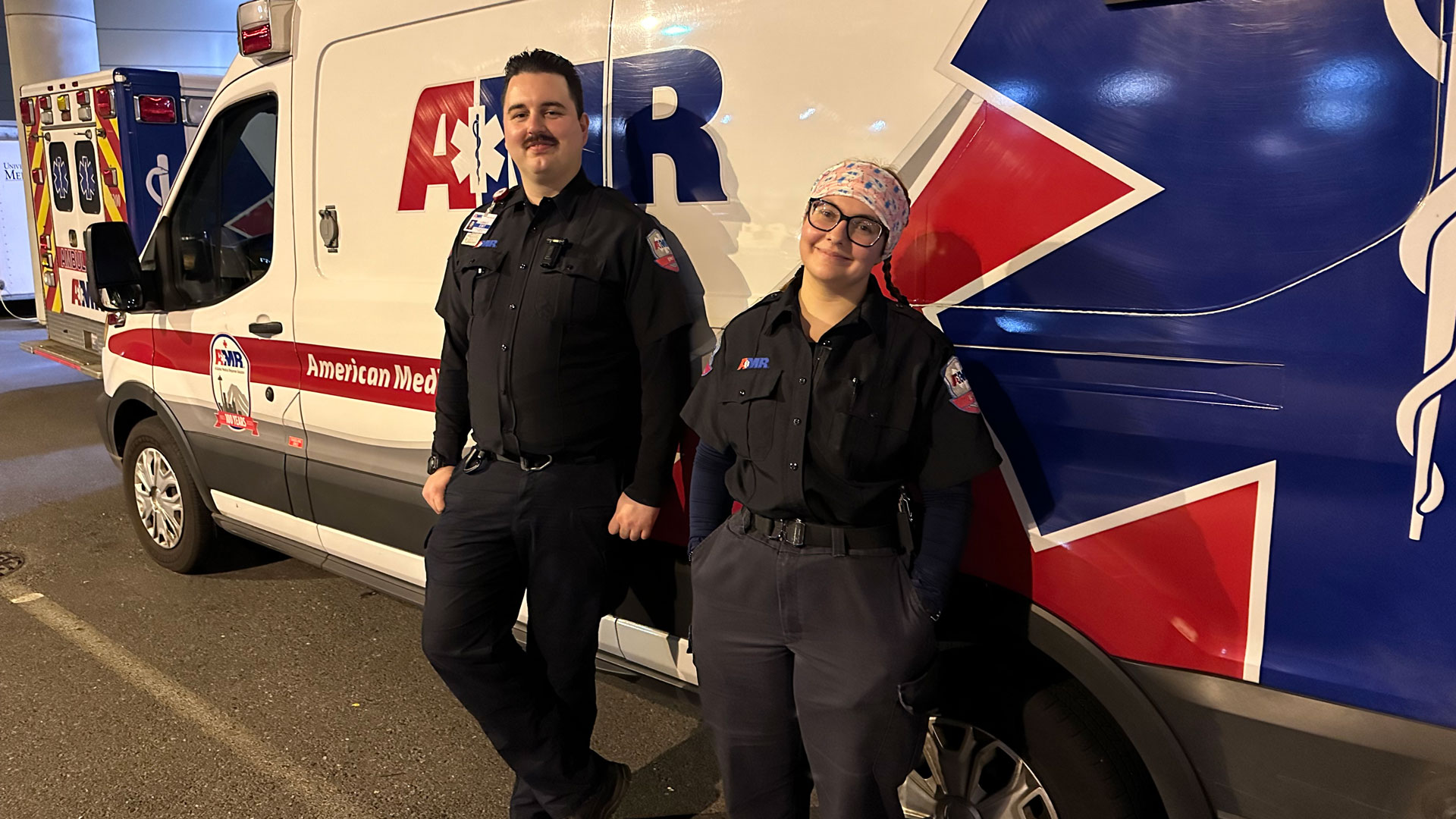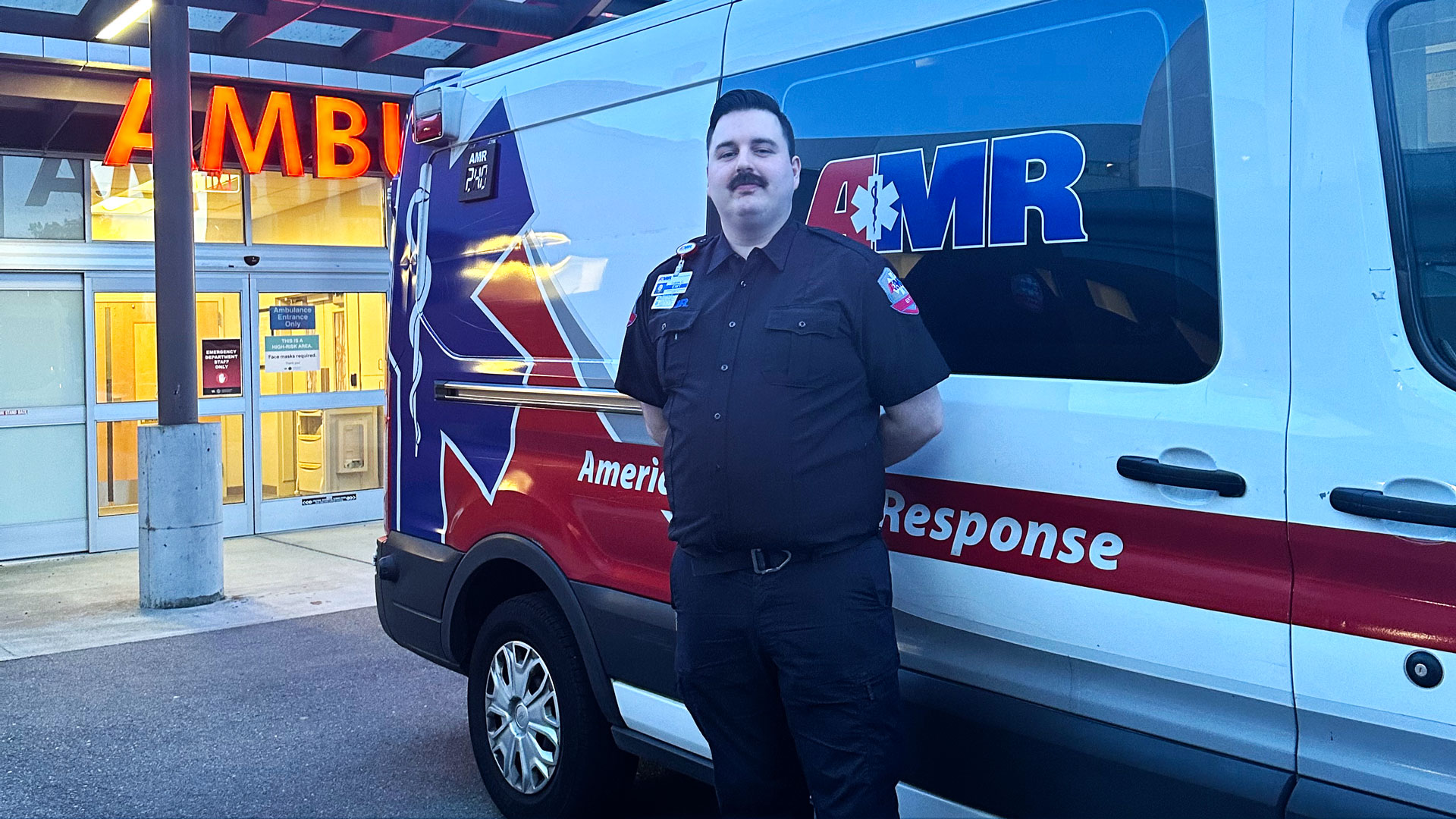It’s Just What We Do
May 16, 2024
Seattle AMR EMTs Use Their Emotional Intelligence to Calm and Comfort a Stressed Patient
Their presence conveys a sense of relief for those experiencing what may be their worst day ever. Their intervention saves lives and, in many cases, happens when time is of the essence. And, while these traits are indisputably critical for anyone who serves in the emergent care industry, there’s another skill that almost every EMS professional possesses and it’s not one that you can learn from an in-person class or through an online course. It’s the ability to quickly understand or assess a situation or individual and provide a response that, among many outcomes, reduces stress.
AMR Seattle, Washington EMTs Shannon Wagner and Lukas Chludzinski demonstrated that important expertise when they responded to a pre-dawn call in February 2024.
“We were dispatched to a call that involved a patient who suffered a visible, minor injury,” said Chludzinski who, along with Wagner, arrived at the scene where they were met by fellow first responders: members of the Seattle Fire and Seattle Police Departments.
“It was a bit of tense scene,” recalled Chludzinski. “There were children present, all under 10 and all looking very confused.”
“What set this call apart from others that we have responded to, was that the patient was ambulatory and didn’t need to be transported on the gurney —something that is typically done on our calls,” said Wagner. “We also had the issue of the patient’s children. The patient didn’t want to go to the hospital for further evaluation and leave their children at the scene, knowing they didn’t have anyone to take care of them.”
This scenario required Wagner and Chludzinski to get creative and find a way to 1) take the patient for a medical diagnosis and 2) tend to the children, whose care and well-being directly affected the patient’s well-being.
“That’s when we took into account that the patient could stand and walk and didn’t require spinal precautions, so I was able to secure the patient on the bench seat next me,” said Wagner.
“We were also able to retrieve the kids’ car seats from the patient’s car and make sure the children were properly secure in the ambulance as well, which was the only way the patient was going to go with us,” added Chludzinski, who went even further to ensure the patient and their children’s mental needs were also met in the best way possible.
“We made sure the patient and their children didn’t have to encounter a loud individual who was interacting with police, so we made sure the ambulance was far away from the police car when the patient and children boarded the ambulance,” said Chludzinski. “We also confirmed that a specialized nurse was available at the hospital we were taking the patient to, so trauma evaluation could be conducted if necessary.”
So, why all the fuss for one patient who appeared to suffer a non-critical injury?
“Whether it’s performing CPR, applying a tourniquet or engaging a patient about a cold that doesn’t seem to be going away after three days, this is what we signed up for; it’s just what we do,” said Chludzinski. “Patient care is our top priority, so we do everything we can to care for the mental and physical needs of the patient and their loved ones, even if it means going out of our way to handle the smallest of logistical concerns: In this case, making sure the patient had their keys, original car seats and that their children had toys while waiting at the hospital before we left the patient at the hospital. Basically, every act of service matters.”
Wagner and Chludzinski’s extraordinary attention to patient details didn’t go unnoticed. Soon after they took the patient and their family to the hospital, leaders from both Seattle Fire and Police Departments called and expressed their deep appreciation for the two EMTs exceptional conduct. Operation Supervisor Jim Diamond also raved about Wagner and Chludzinski’s work.
“The commendations [from the police and fire departments] praised their exemplary patient care, highlighting the compassion and proficiency they exhibited in managing the scene with kindness and compassion,” said Diamond.
“Yes, our response was definitely unconventional, but I felt it was emotionally valuable to keep the family together,” said Wagner, who adds that she was quite astonished by the attention she and Chludzinski received.
“I was honestly surprised but honored to receive recognition for this call,” said Wagner. “In my mind, I simply did what was best for my patient as well as for their children. Advocating for the best care and outcome for my patients is something I strive for on all my calls. It’s just what we do.”
AMR Seattle, Washington EMTs Shannon Wagner and Lukas Chludzinski demonstrated that important expertise when they responded to a pre-dawn call in February 2024.
“We were dispatched to a call that involved a patient who suffered a visible, minor injury,” said Chludzinski who, along with Wagner, arrived at the scene where they were met by fellow first responders: members of the Seattle Fire and Seattle Police Departments.
“It was a bit of tense scene,” recalled Chludzinski. “There were children present, all under 10 and all looking very confused.”
“What set this call apart from others that we have responded to, was that the patient was ambulatory and didn’t need to be transported on the gurney —something that is typically done on our calls,” said Wagner. “We also had the issue of the patient’s children. The patient didn’t want to go to the hospital for further evaluation and leave their children at the scene, knowing they didn’t have anyone to take care of them.”
This scenario required Wagner and Chludzinski to get creative and find a way to 1) take the patient for a medical diagnosis and 2) tend to the children, whose care and well-being directly affected the patient’s well-being.
“That’s when we took into account that the patient could stand and walk and didn’t require spinal precautions, so I was able to secure the patient on the bench seat next me,” said Wagner.
“We were also able to retrieve the kids’ car seats from the patient’s car and make sure the children were properly secure in the ambulance as well, which was the only way the patient was going to go with us,” added Chludzinski, who went even further to ensure the patient and their children’s mental needs were also met in the best way possible.
“We made sure the patient and their children didn’t have to encounter a loud individual who was interacting with police, so we made sure the ambulance was far away from the police car when the patient and children boarded the ambulance,” said Chludzinski. “We also confirmed that a specialized nurse was available at the hospital we were taking the patient to, so trauma evaluation could be conducted if necessary.”
So, why all the fuss for one patient who appeared to suffer a non-critical injury?
“Whether it’s performing CPR, applying a tourniquet or engaging a patient about a cold that doesn’t seem to be going away after three days, this is what we signed up for; it’s just what we do,” said Chludzinski. “Patient care is our top priority, so we do everything we can to care for the mental and physical needs of the patient and their loved ones, even if it means going out of our way to handle the smallest of logistical concerns: In this case, making sure the patient had their keys, original car seats and that their children had toys while waiting at the hospital before we left the patient at the hospital. Basically, every act of service matters.”
Wagner and Chludzinski’s extraordinary attention to patient details didn’t go unnoticed. Soon after they took the patient and their family to the hospital, leaders from both Seattle Fire and Police Departments called and expressed their deep appreciation for the two EMTs exceptional conduct. Operation Supervisor Jim Diamond also raved about Wagner and Chludzinski’s work.
“The commendations [from the police and fire departments] praised their exemplary patient care, highlighting the compassion and proficiency they exhibited in managing the scene with kindness and compassion,” said Diamond.
“Yes, our response was definitely unconventional, but I felt it was emotionally valuable to keep the family together,” said Wagner, who adds that she was quite astonished by the attention she and Chludzinski received.
“I was honestly surprised but honored to receive recognition for this call,” said Wagner. “In my mind, I simply did what was best for my patient as well as for their children. Advocating for the best care and outcome for my patients is something I strive for on all my calls. It’s just what we do.”

